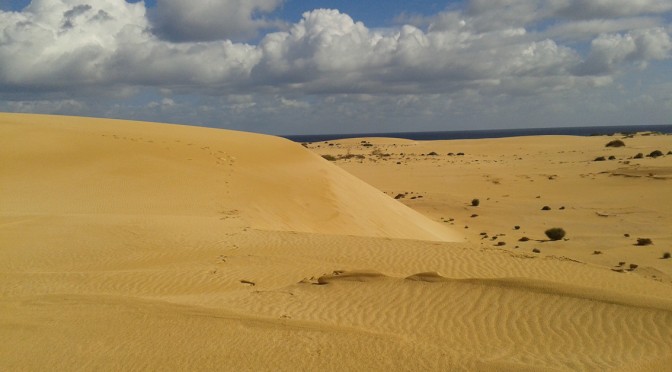Our boat trips from Corralejo towards the islet of Lobos is characterised by the breathtaking views of its landscape behind us: The Dune Natural Parc in Corralejo.
This is a huge expanse of golden sand taking up 2668,7 yellowish hectares in stark contrast with the deep blue of our sky and the turquoise shades of the water in the Eastern coast of Fuerteventura.
The Dune Natural Park, where the islet of Lobos belongs too, was designated as such on the 15th October 1982, and it was definitely reclassified as Natural Park on the 19th December 1994 by the Law on Natural Sites in the Canary Islands.
The formation of the Dunes making up this park is completely organic, that is, they have originated due to the build-up, in the North of the island, of remains of shells of thousands of molluscs and other marine organisms with an external skeleton which has been disaggregated and pulverised. These remains are deposited there by the sea and once they get dry they are heaped by wind currents. The wind creates different shapes in dunes, as for example ripples, which are small waves, and the strength of the wind makes dunes not be fixed but move slowly, either independently or in strings that move crosswise the wind direction.
Dunes are a very fragile system, as any within-range obstacles in the dunes field will cause a change in its dynamics. Usually, in front of the dune fields some pre-dunes are formed beside the coastline, and being closer to the sea and wetter they don’t move, so some vegetation grows there which prevents them from moving even more. This pre-dune acts as a barrier, greatly stopping the erosive strength of the sea wind, mainly in stormy periods.
Under the several meters of deposited thin white sand you can sometimes make out the “malpaís” foundations (rocks with very sharp cutting edges), characteristic of this volcanic area.
The dunes border to the North with the village of Corralejo, and to the South with the “malpaís” in Montaña Roja, the Eastern border being this huge Ocean of heavenly turquoise waters where a dive can become the most idyllic entertainment.
The scientific value of these dunes is very important and they are inhabited by several protected and threatened endemic species, which is why they have been designated special protection area for birds (ZEPA) and, from the 13th July 1990, area of biological sensitivity, according to the Environmental impact prevention law. Among the birds we can find in the area we have the Houbara bustard (really scarce) Cursorius cursor, pteroclidae, ash-grey eaglet, the kestrel, anthus and calandrella rufescens or saxicola dacotiae.
And in what seems a true desert we find out the existence of some brave plants, able to stand the harsh weather in this area, the absence of sweet water, and the great salinity of the area. This is the case of the Androcymbium gramineum psammophilum, threatened and protected endemic species. We also find allium christophii, aeonium, narcissus jonquilla and hawthorns.
The Dune Natural park in Corralejo is one of the main tourist attractions in the island of Fuerteventura, and its dunes are the biggest in the Canary Archipelago, though the ones in Maspalomas (Gran Canaria) are also of great importance. In ancient times other sand dunes were also important like the ones in El Jable (Lanzarote), Jandia (Fuerteventura) or Guanarteme (Gran Canaria).
Sand dunes, apart from being a tourist attraction by themselves, gathering every day a great deal of tourists, are a clear indicator of beaches of quality and no doubt in the East of the Majorera coast the most heavenly beaches in our island of Fuerteventura are found, wrapped in this blanket of dunes of imponderable beauty.
El equipo de FuerteCharter
